FAQ & Blog
Know Your Teeth?
People have two sets of teeth in their lives, the primary teeth (also called the baby, milk or deciduous teeth) and the permanent teeth (also called the adult or secondary teeth). Children have 20 primary teeth; they are replaced by the permanent teeth by about age 13. Adults have 32 permanent teeth.
Teeth are used to bite and chew food- they are the first step in the digestion of food. The long, sharp canine teeth tear up food (like meat). The wide, flat molars grind and mash up food. While we chew food, the tongue pushes the food to the teeth and saliva helps digestion and wets the food. Teeth also help us say certain sounds. The shape of the arch inside the mouth helps you talk. Many letters of the alphabet cannot be sounded without the help of teeth.
Primary Teeth: Most babies are born with no teeth showing (the teeth are forming inside the gums). The 20 primary teeth (also called baby teeth or first teeth) erupt (poke through the gums) over the time from when a baby is from about 6 months to a year old.
Permanent Teeth: Primary teeth fall out and are replaced by 32 permanent teeth (also called the adult teeth). This happens over the time from when a child is from about 6 to 14 years old.
As a permanent tooth forms under the gums and in the jawbone, the roots of the primary tooth it is replacing dissolve. Then the primary tooth becomes loose and falls out. The permanent tooth will fill the space.
Wisdom Teeth: Wisdom teeth (also called the third molars) are molars that usually erupt from the ages of 17 to 21.
Teeth vary in size, shape and their location in the jaws. These differences enable teeth to work together to help you chew, speak and smile. They also help give your face its shape and form.
At birth people usually have 20 primary (baby) teeth, which often erupt as early as six months of age. They are then shed at various times throughout childhood. By age 21, all 32 of the permanent teeth have usually erupted.
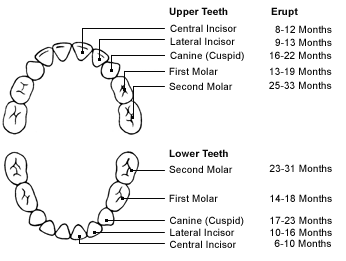
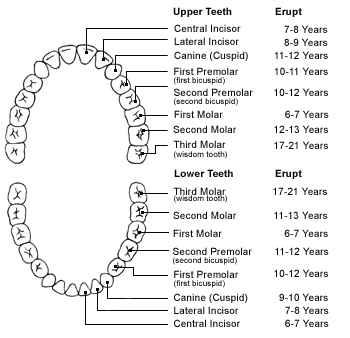
Parts of your tooth:
The human tooth has two primary components: the crown and root. The crown is the portion of the tooth that projects above the gums while the root is that portion that anchors the tooth to the bone.
The teeth are composed of 4 tissues. The enamel covers the crown of the teeth and is the hardest known substance in the human body. This extreme hardness is necessary to survive the powerful forces exerted on the tooth surface during chewing.
Inner to the enamel is the dentin forming the bulk of the tooth. Cementum covers the root portion of the tooth and gives attachment to certain fibers called periodontal ligament that help the tooth attach to the jaws.
The Pulp is the innermost part of the tooth containing the nerves, blood vessels and other cells. The pulp is the vital area of the tooth. Gums are soft tissues that cover the tooth like a collar.
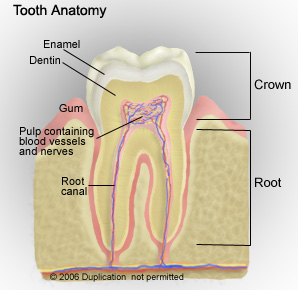
Anterior Tooth
Teeth have different shapes for different jobs. For example, when you eat, the upper teeth work together with the lower teeth of the same shape to bite, chew, and tear food. The names of these teeth are
- Incisors (Central & Lateral) - There are eight incisors located in the front of the mouth (four on the top and four on the bottom). They have sharp, chisel-shaped crowns that cut food.
- Cuspids / Canines - The four cuspids are next to each incisor. Cuspids have a pointed edge to tear food.
- Premolars - Also called bicuspids, the four pairs of premolars are located next to the cuspids. They crush and tear food.
- Molars - There are twelve molars, in sets of three, at the back of the mouth. They have wide surfaces that help to grind food.
Adults have 32 teeth. Depending on their age, children may have fewer because they lose baby teeth as adult teeth grow. In addition to chewing, teeth help you to speak clearly.
"Teeth also give your face its shape and add to the way you look. Not only do clean, healthy teeth help you look good, they contribute to total body health and well-being. And a smile always helps you look your best."
How to Brush Your Teeth?
Regular, thorough brushing is a very important step in preventing tooth decay and gum disease. Brushing removes the bacteria that promote tooth decay and the plaque that can cause gum disease.
Ideally, you should brush after every meal, because the bacterial attack on teeth begins minutes after eating. At the very least, brush once a day and always before you go to bed. Brushing your teeth isn't complicated, but there is a right and a wrong way. We do it every day without thinking too much, but there are some important points to remember when brushing your teeth
Here are a few tips to help your brush better:
- Squeeze some toothpaste onto a soft-bristled toothbrush. Your toothpaste should contain fluoride
- Use short, back-and-forth brushing motions to clean the outside and inside surfaces of the teeth, as well as the chewing surfaces. Follow with up-and-down motions to clean the inside surfaces of the front teeth.
- Clean every surface of every tooth.The chewing surface, the cheek side, and the tongue side.
- Don't rush your brush. A thorough brushing should take at least two to three minutes. Try timing yourself.
- Brush along the gum line. This is extremely important, as gum disease starts here. Brush gently to avoid damaging your gums.
- Make sure to brush your back molars, where bacteria like to hide.
- Brush your tongue to remove bacteria that cause bad breath.
- Spit out the toothpaste and rinse your mouth with water or mouthwash.
- Use a soft brush with rounded bristles. The right toothbrush cleans better. Choose a size and shape that allow you to reach all the way to your back teeth. There are many different types of brushes, so ask your dentist to suggest the best one for you. It is recommended you replace your toothbrush every three months.
- Try to floss at least once a day, since most adult cavities occur between teeth. The most important time to floss is before going to bed. Floss before or after you brush'either is fine. Guide the floss between the teeth and use it to gently rub the side of each tooth.
How to Floss your teeth?
Flossing removes plaque and bacteria that you cannot reach with your toothbrush. If you don't floss, you are missing more than one-third of your tooth surface. Plaque is the main cause of gum disease. It is an invisible bacterial film that develops on your teeth every day.
Within 24 to 36 hours, plaque hardens into tartar (also called calculus) which can only be removed by professional cleaning. Floss at least once a day, and plaque never gets the chance to harden into tartar. Getting into the habit of daily flossing is easier when you floss while doing something else like watching TV or listening to music, for example.
Here is the suggested way to floss right
Step 1 - Take a length of floss equal to the distance from your hand to your shoulder. Wrap it around your index and middle fingers, leaving about two inches between your hands.
Step 2 - Slide the floss between your teeth and wrap it into a "C" shape around the base of the tooth and gently under the gumline. Wipe the tooth from base to tip two or three times.
Step 3 - Be sure to floss both sides of every tooth. Don't forget the backs of your last molars. Go to a new section of the floss as it wears and picks up particles.
Step 4 - Brush your teeth after you floss — it is a more effective method of preventing tooth decay and gum disease.




Note:Gums sometimes bleed when you first begin to floss. Bleeding usually stops after a few days. If bleeding does not stop, see your dentist. Floss can shred if you snag it on an old filling or on the ragged edge of a tooth. Try another type of floss or dental tape. Ask your dentist for advice. If your floss still shreds, see your dentist.
What is Plaque?
Plaque is the accumulation of bacteria, microorganisms and their products which sticks to the tooth surfaces. Dental plaque is soft and easily removed by brushing and flossing the teeth. Accumulation of plaque can lead to gum disease (gingivitis) and periodontal disease, as well as tooth decay.
What is Calculus (Tartar)?
Calculus is dental plaque that has mineralized. Calculus can form when plaque is not removed from the tooth surfaces. This plaque becomes old and eventually forms into calculus. Calculus can form above or below the gumline. The bacteria that sticks to calculus can cause gum disease (gingivitis) or periodontal disease. Calculus cannot be removed by brushing and flossing. A dental hygienist checks for calculus formation when you visit the dental office. It is removed with special instruments designed to adapt to the tooth surface affected without causing trauma to the soft gums.
What is Gingivitis?
Gingivitis is inflammation of the gums. Some common features associated with gingivitis are red and swollen gums, and the presence of bleeding while brushing and flossing. The cause of gingivitis is the bacteria in dental plaque. This disease is reversible with good oral hygiene practices.
What is Periodontal Diseases?
Periodontal disease is destruction of bone and the structures supporting the teeth. Unfortunately periodontitis is irreversible, but you can stop its progression through good oral hygiene and visiting your dental professional.
- Gums that bleed when you brush or floss your teeth.
- Gums that are red, swollen or tender.
- Gums that have pulled away from teeth.
- Infection including purulence(pus) between the teeth and gums when the gums are pressed.
- Permanent teeth that are loose or separating.
- Any changes in the way your teeth fit together when you bite.
- Any changes in the fit of your partial denture.
- Bad breath.
- Itchy sensation.
What is a Cavity?
A cavity is the destruction of the tooth enamel, dentin, cementum and may involve the tooth pulp.
- How does a Cavity Form?
- Signs of a Cavity Formation
- White spot phase
- Breakdown of enamel between the teeth
- Good Habits to Help Prevent Cavities
- regular visits with your dental professional on an appointment schedule that he/she recommends based on your own needs. Regular visits will ensure you have the benefits of preventive care and early diagnosis, as well as, treatment for any dental problems. Guidance about home dental care can also be provided to avoid future problems.
- diet plays an important role. Minimize the frequency of sugary foods, thus reducing the amount of acid produced. Select snacks that are less cavity causing, such as fresh fruit, plain yogurt and raw vegetables.
- the use of fluoride will help decrease the risk of cavity formation.
- good plaque control. Maintain a strict and regular home care routine to minimize plaque growth.
- it is recommended that you consult your dental professional before using any commercial products. You want to make a selection based on the effectiveness of the product and your own personal needs.
The formation of a cavity is due to many factors. For example, the tooth itself plays a role (how strong it is); the mouths ability to cleanse itself (your flow of saliva); diet (frequency and selection of sugary foods); the bacteria in your mouth (good or bad); and the length of time the tooth is under attack by the bacteria in your mouth.
The first sign of a cavity forming may be a white spot, which in time may turn brown.
If it is a white spot, low concentrations of fluoride applied frequently can arrest further development.
If the white spot phase progresses, further breakdown of enamel will occur. At this point, a visit to your dental professional is necessary. The cavity may be restored with a filling.
What is Bad Breath (Halitosis)?
Bad breath (halitosis) can cause embarrassment, create social and psychological barriers , and even affect marriages.
CAUSES: The majority of bad breath problems begin in the mouth.
- Bad breath that is of oral cavity origin can be traced to a sulfur compound produced by bacteria. Dead and dying bacterial cells release this sulfur compound, which gives the breath an unpleasant odor.
- Bacterial plaque and food debris accumulate on the back of the tongue. The tongue's surface is extremely rough and bacteria can accumulate easily in the cracks and crevices.
- The tooth attracts bacteria containing plaque and if not cleaned regularly and thoroughly, this can result in large accumulations of bacteria which result in bad breath.
- People who have periodontitis often experience bad breath because of bacteria accumulating in areas that are not cleaned easily, such as deep pockets around teeth.
- Fortunately, treatment is very effective for people who have bad breath of mouth origin.
What is Orthodontics (Braces)?
Orthodontics is the science of straightening and correcting teeth.
- Who Needs Orthodontic Treatment?
- Children as well as adults, are choosing to have orthodontic treatment for several reasons:
- Malocclusion (bite or occlusion is off)
- Tooth malalignment (crooked teeth)
- Unhappy with appearance of teeth
- During the preteen and teenage years, the jaws are growing and maturing, therefore it is easier to shift teeth at this stage rather than later on in adulthood.
- More adults are choosing to have orthodontic treatment in order to improve the appearance of their teeth. Since their jaws are no longer growing, treatment may take a little longer.
What is an Impacted Wisdom Tooth ?
A tooth becomes impacted due to lack of space in the dental arch and gum, bone, another tooth or all three therefore prevent its eruption. Lack of space occurs because our jaws have become smaller (through evolution), we do not loose teeth through decay as frequently as in the past, and our diet is such that our teeth do not wear down as much.
What is Root Canal Treatment?
Today, with modern dentistry, root canal treatment has become a common form of treatment for diseased (abscessed) teeth.
HERE'S HOW IT'S DONE: In healthy teeth, the interior of the tooth is filled with tissue (pulp). Once the tooth is injured, cracked, or decayed, it is necessary to open the tooth and clean out the infected tissue in the centre. This space is then filled and the opening sealed. During the procedure the area around the tooth is frozen. Sometimes difficulties may be encountered during or after root canal treatment. This may require the use of medication or involve further treatment. A crown or cap may be necessary to protect the tooth, once the root canal treatment has been completed.
Teeth that have had root canal treatment can stay as healthy and last as long as other teeth. In most instances, you won't be able to feel or see a difference.
Refer the general dentistry section of this site for a detailed explanation.
What is a Crown/Cap?
A crown or cap is a cover that fits over a properly prepared tooth that has been damaged by decay or accident, or is badly stained or shaped.
A crown can be made of acrylic, metal, porcelain, porcelain and metal, or resined metal. All-porcelain crowns look more like your natural teeth, and therefore are usually used for front teeth; while porcelain with metal underlay has more strength and is good for crowns in the back of the mouth. Sometimes all-metal crowns are used for back teeth because of the metal's strength.
HERE'S HOW IT'S DONE: In order to prepare your tooth for a crown, you require a local anaesthetic. Then the tooth is filed down so the cap can fit over it. An impression of your teeth and gums is made and a temporary cap is fitted over the tooth until the permanent crown is made. On your next visit, the dentist will remove the temporary cap and cement the crown onto the tooth. The crown will closely match your natural teeth and give you back your smile.
What Are Dentures?
Dentures are a set of replacement teeth for any teeth that are missing. There are partial dentures, which take the place of only a few teeth and prevent the others from changing position, and complete dentures, which replace every tooth in the mouth. Both types of dentures are removable and usually made of metal and acrylic resin (say: ah-kri-lick reh-zen), a plastic-like material that is molded to fit the exact shape of a person's mouth. Dentures are held in place with the help of a sticky cream that helps the dentures stick to the surface of a person's gums.
Although they may sound uncomfortable to wear and aren't always fun to look at (especially if someone takes out his dentures in front of you), dentures are important for older folks who have lost their teeth. They help a person chew, talk, and even smile! Because they are custom-made by dentists from molds of a person's mouth (much like a retainer), each set of dentures is as unique as the person who wears them. No buying them off the shelf at the denture store!
If you know someone with dentures, don't make fun of the dentures or act grossed out. After all, you know plenty of kids with braces and retainers, right? Dentures aren't all that different. For the person wearing them, they may take some getting used to at first. If you've had braces, you may remember how it took a while to get used to having a mouth full of metal. Your mouth may have felt sore, you may have had more saliva (spit), and it may have hurt to talk for a few days. It's the same with dentures. Like braces or retainers, they also need special care - they need to be brushed daily with a special denture brush and cleanser or toothpaste and soaked in denture solution when not in the mouth.
Wisdom Teeth: To Keep or Not
What are wisdom teeth?
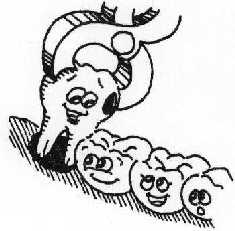
These are not extra teeth like most of us think. They are part of our normal set of teeth. Each one of us has 32 teeth. 28 would have erupted into the mouth by the time we are 13 years of age. The last four, one in each end of the upper and lower jaws are the wisdom teeth. There is a sequence of eruption and it just so happens that the wisdom teeth are the last ones to erupt at the age of 18 to 24 years of age. By then there is usually a lack of space for them to erupt properly and so most are always stuck(IMPACTED). So we always have this idea that they are extras!
Do we need to remove them?
There criteria most Dental Surgeons will have to determine whether that wisdom tooth of yours need to be removed.
These are:
- They have given you gum pains before. These pains will usually subside after some medications and then will recur at a later date. No one can predict the frequency and severity of these recurring pains. They may or may not be accompanied by swelling and pustulent products.
- They have caused cavities in the teeth in front of them due to food trapping or they themselves have cavities from food trappings. These are usually determined by the dental surgeons after a check up or through x-rays results.
- They interfere with the treatment you are having. Usually this will happen in those who seek braces treatment.
- They are constant causes of food trapping and irritation.
What is an Impacted Wisdom Tooth ?
A tooth becomes impacted due to lack of space in the dental arch and its eruption is therefore prevented by gum, bone, another tooth or all three. Lack of space occurs because our jaws have become smaller (through evolution), we do not loose teeth through decay as frequently as in the past, and our diet is such that our teeth do not wear down as much.
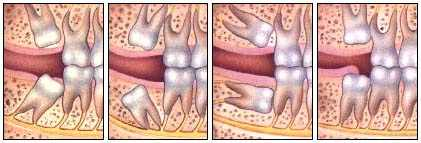
How are they removed?
There are two methods of removing wisdom teeth. They can be by simple extraction or they are removed by simple minor surgical procedures. These are determined by their degree of impaction.
Removing wisdom teeth either by extraction or surgery can be performed under local anaesthesia or under general anaesthesia.
Local anaesthesia means that they can be done in the clinic when you are fully awake or sedated.
General anaesthesia will mean removing them while you are asleep and is usually done in a hospital environment under Day Surgery.ie. you go home about four hours after the procedure is performed. These can be carried out either in the private hospitals or restructured hospitals. The surgeons can be private practitioners or from government service.
The healing process begins immediately after surgery as your body sends blood to nourish the tooth socket. Simple pressure from a piece of gause is usually all that is needed to control the bleeding and to help a blood clot to form in the socket, which promotes healing. Within a day or two, soft tissue begins to fill in the socket, aided by the blood clot. Eventually, the bone surrounding the socket begins to grow, eventually filling in the socket completely, as illustrated here:

(note that there is a possibility of a swelling developing in the area which is normal and will reduce within a short time)
The Pro's and Con's of Wisdom Tooth Removal
Some Pro's of Removing a Wisdom Tooth:
- Wisdom teeth may be hard to access with your toothbrush or floss. Over time, the accumulation of bacteria, sugars and acids may cause a cavity to form in the tooth. If it is not restored with a filling, the cavity may spread and destroy more tooth structure causing severe consequences to the tooth and surrounding supportive structures.
- Due to the difficulty of keeping these teeth clean with your daily home care (brushing and flossing), bacteria and food debris remaining on the wisdom teeth may produce a foul smell-causing bad breath.
- A wisdom tooth that is still under the gums in a horizontal position (rather than a vertical position) may exert pressure to the surrounding teeth, causing crowding and crooked teeth. This also may occur if there is not enough space in the mouth for the wisdom tooth. This may warrant braces to repair the damage.
- A wisdom tooth that is still under the gums may become irritated. The gum tissue that lays over the tooth may harbor food debris and bacteria that gets trapped under the gum, resulting in an infection in the gums.
Some Con's of Removing the Wisdom Teeth:
- Depending on the size shape and position of the tooth, removal can vary from a simple extraction to a more complex extraction. With a simple extraction, there is usually little swelling, bruising and/or bleeding. More complex extraction will require special treatment, which may result in more bruising, swelling and bleeding. However, your dental professional will provide you with post treatment instructions to minimize these side effects.
- Following an extraction, a condition called "dry socket" may occur. If the blood clot that formed in the extraction area becomes dislodged, it exposes the underlying bone. This condition is very painful, but resolves after a few days. It is preventable by following the post treatment instructions provided by your dental professional.
- The longer you wait and the older you get, there is the potential for more problems to occur. This is because as you get older, the bone surrounding the tooth becomes more dense, making the tooth more difficult to remove. The healing process may also be slower.
Post Operative Care
- Do Not Disturb the Wound - In doing so you may invite irritation, infection and/or bleeding. Chew on the opposite side for the first 24 hours.
- Do Not Smoke for 12 Hours - Smoking will promote bleeding and interfere with healing.
- Do Not Spit or Suck Through a Straw - This will promote bleeding and may dislodge the blood clot, which could result in a dry socket.
- Control of Bleeding - If the area is not closed with stitches, a pressure pack made of folded sterile gauze pads will be placed over the socket. It is important that this pack stay in place to control bleeding and to encourage clot formation. The gauze is usually kept in place for 30 minutes. If the bleeding has not stopped once the original pack is removed, place a new gauze pad over the extraction site.
- Control of Swelling
- Medication for Pain Control - Anti-inflammatory medication such as Ibuprofen is used to control minor discomfort following oral surgery. The dentist may prescribe stronger analgesics if the patient is in extreme discomfort.
- Diet and Nutrition - A soft diet may be prescribed for the patient for a few days following surgery.
After surgery, some swelling usually expected mainly due to the reason that in some cases some bone covering that particular tooth may need to be removedwhich leads to swelling. This can be controlled through the use of cold packs (ice cube wrapped in a hand towel or kerchief.A cold pack is usually placed at the site of swelling during the first 24 hours in a cycle of 20 minutes on and 20 minutes off.
After the first 24 hours, it is advisable to rinse with warm saltwater every two hours to promote healing. (one teaspoon of salt to eight ounces of warm water).
Following the removal of your wisdom teeth it is important that you call your dentist if any unusual bleeding, swelling or pain occurs. The first 6-8 hours after the extraction are typically the worst, but are manageable with ice packs and pain medication. You should also plan to see your dentist approximately one week later to ensure everything is healing well.
It is very important to talk to your dentist about extraction procedure, risks, possible complications and outcomes of the removal of these teeth. A dentist may do the actual extraction or it may be referred to an oral surgeon, who is a specialist in the field. This decision is based on the dentist's preference and the unique features severity of each individual case.
Tooth Whitening
Want Whiter, Brighter Teeth?
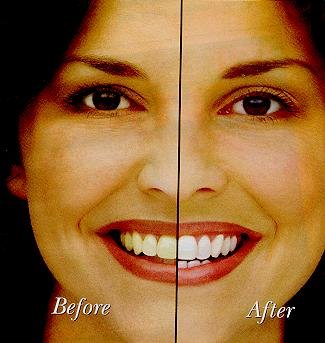
The best way to keep your teeth white is to brush twice a day, floss daily, see your dentist for regular checkups and professional cleanings, and limit stain-causing foods and habits. These include: tobacco, certain foods and beverages (such as coffee, tea and berries), some drugs (such as tetracycline), or trauma to a tooth. As well, your teeth may become stained or discoloured naturally as you age. Your dentist can give you the best advice about whitening your teeth.
HERE'S HOW IT'S DONE: Chairside bleaching - usually takes about 30 to 60 minutes and one to three visits to the dental office. A shield (or rubber dam) protects your gums from the bleaching agent (usually a form of hydrogen peroxide), which is "painted" onto your discolored teeth and activated with heat or high-intensity light.
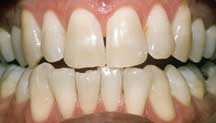
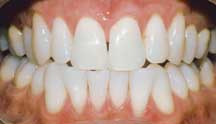
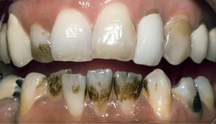
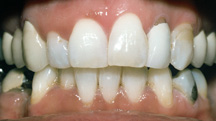
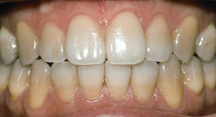
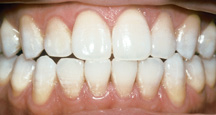
Mouthguard Bleaching - is done by you at home. You wear a custom-made mouthguard with special bleaching gel (provided by your dentist) for a period of time each day, or overnight, over a number of weeks.

It's important to know that not everyone's teeth will "whiten" the same. It depends on the number of teeth involved and the severity of discoloration. Over-the-counter, at-home whiteners are not recommended because they may cause problems associated with over exposing gum tissues to the active whitening agent. Any bleaching treatment should be done under your dentist's supervision.
Veneers
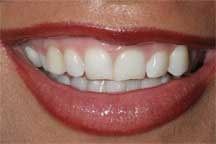
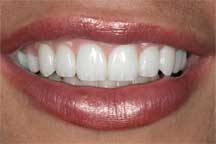
Can I Improve My Smile?
Are you too self conscious to smile because your teeth are chipped, discolored, or poorly spaced? Cheer up, your dentist may be able to apply a porcelain laminate veneer to your teeth and give them a whole new appearance. Veneers are strong, thin pieces of porcelain that are bonded to the teeth. They are used to repair chipped, decayed or stained teeth and for closing gaps between teeth. With a bit of contouring, veneers can also rectify crowded or overlapping teeth. If your teeth have discolored with age, a veneer may improve their appearance. Veneers can also be used for cosmetic reasons instead of crowns, which are more often used for badly damaged or decayed teeth.
HERE'S HOW IT'S DONE: The tooth needs to be ground down and the veneer replaces the ground off surface. Veneer preparations frequently require the use of local anaesthetic and, depending on color and shade, may take two or more appointments to complete. Ask your dentist if veneers can help improve your smile.
The best way to keep your teeth white is to brush twice a day, floss daily, see your dentist for regular checkups and professional cleanings, and limit stain-causing foods and habits. These include: tobacco, certain foods and beverages (such as coffee, tea and berries), some drugs (such as tetracycline), or trauma to a tooth. As well, your teeth may become stained or discoloured naturally as you age. Your dentist can give you the best advice about whitening your teeth.
Bridges
A FIXED BRIDGE is a replacement that is cemented to the adjacent teeth and cannot be removed.
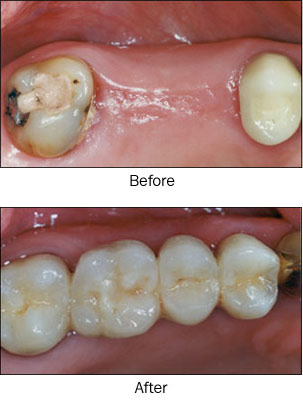
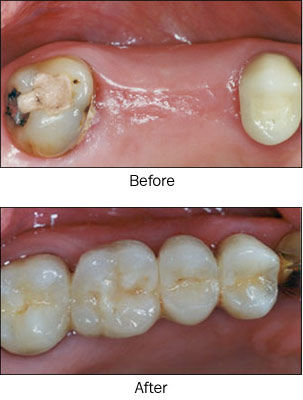
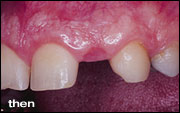
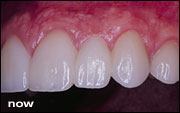
Tooth Loss and How to Prevent It
Did you know that about 30% of adults over age 65 no longer have any natural teeth?! Tooth loss is more common in older folks who didn't have the benefit of growing up with fluoride (a mineral that helps keep teeth healthy and strong) in their water and other advances in dental care.
People usually need dentures because they've lost teeth due to:
periodontal (say: per-ee-oh-dahn-tel) disease, or gum disease, which is caused by a buildup of plaque (a film that sticks to your teeth) and bacteria that attacks the gums.
tooth decay (cavities), which happens in older adults more often because gums recede (become soft and worn down) as people age.
These problems get worse over time, especially if a person doesn't take care of his/her teeth, doesn't regularly see a dentist for cleanings and tooth care, or has health complications like diabetes or stroke. Some medications that older people may need to take every day can dry out the mouth and prevent good saliva flow, which is important in washing away food debris and keeping the mouth healthy.
So, what can you do to prevent anyone you know - as well as yourself - from needing dentures in the future? Take care of your teeth and urge other kids and adults you know to do so, too! Here's how:
Carefully and gently brush your teeth twice a day with a toothpaste containing fluoride. Use a toothbrush with soft bristles, and try to remember not to brush too hard, which can cause gums to recede. If your toothbrush is all bent out of shape from the way you're brushing, then you're brushing too hard!
Don't know how long to brush? Put on your favorite song. You should brush almost as long as the song.
Be sure to floss your teeth at least once a day.
Visit the dentist twice a year for a professional cleaning and checkup. Tell the dentist if you are experiencing gum pain or swollen gums or if your gums bleed when you brush.
Don't drink or smoke. Smoking or chewing tobacco increases the risk of gum disease. Alone or paired with alcohol, tobacco increases the risk of throat and mouth cancers.
Drink plenty of water (six to eight glasses a day) and avoid sugary snacks and soft drinks between meals.
COMPLETE DENTURES
What are Complete Dentures?
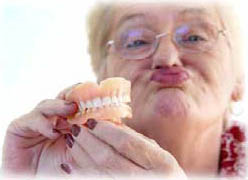
Complete dentures replace all of the natural teeth in the upper or lower jaw, or both, sitting on the soft (gum) tissue of the mouth that covers the bone ridge. Your dentist may use several different procedures to make sure your denture will fit the shape of your mouth, and provide the necessary support for your face. The design of the complete denture and position of the teeth will restore good speech and appearance.
Types of complete dentures
A full denture, also called a complete denture, replaces natural teeth and provides support for cheeks and lips. Without support from the denture, facial muscles can sag, making a person look much older. There are the following types of complete dentures:
Conventional full denture: after patient's remaining teeth are removed and the gum tissues have healed, this kind of denture is made and placed inside the mouth. The process for tissue healing may take months.
Immediate full denture: The denture wearer does not have to wait during the healing period because after teeth removal, this kind of denture is made and inserted into patient's mouth.
How are dentures made?
Your dentist will take an impression of your jaw, along with measurements of how your jaws relate to one another and how much space is between them (bite relationship). The color (shade) of your teeth will also be determined either from your natural teeth or a denture you may already be wearing. The impression, bite and shade are given to the dental laboratory so a denture can be made just for you.
The dental laboratory makes a mold (model) of your jaw, places the teeth in a wax base, and carves the wax to the exact form wanted in the finished denture. Usually a "wax try-in" of the denture will be done at the DENTAL CLINIC so any adjustments can be done before the denture is completed.
The denture is completed at the dental laboratory using the "lost wax" technique. A mold of the wax-up denture is made, the wax is removed and the remaining space is filled with pink plastic in dough form. The mold is then heated to harden the plastic. The denture is then polished and ready for the patient to wear.
Wearing Your Dentures
It usually takes a little while to get used to wearing a full denture. There may also be minor adjustments that your dentist will make to fine tune the fit of your denture. After a few weeks, you will be more at ease and your gums adapted to wearing a full denture.
It is very important that you wear your denture every day. If you don't wear your denture for an extended period of time, the denture may no longer fit as well as it should.
Over time, your mouth will change. The bone and gum areas may shrink or recede, causing the space between the jaws to change. Because your denture keeps its shape, adjustments will be needed to keep your denture fitting properly. Always consult your dentist rather than trying to fix the problem yourself. Trying to adjust them yourself will only cause more difficulties and what may have started out as a small problem could easily become a bigger one.
Getting Used to Your Denture
It will take a bit of time to get used to your new denture, particularly if it is your first. Unfortunately, a complete denture will not feel like your teeth did when you had them. They should, however, become comfortable and functional with time.
Speaking- At first you will have some difficulty with speaking and this is to be expected. Some people describe this as trying to talk with a "mouth full of marbles". Be patient; you will quickly adapt with practice and soon you will find you can not speak properly without your denture. There is no way to predict how long this will take, each patient adapts at a different rate.
Eating- Eating takes practice as well. The important thing to remember is that you do not chew with your denture as you did when you had teeth. Natural teeth chew in an up and down motion. Denture teeth, on the other hand, use a side to side motion to mash down the food. Always cut your food into small pieces for more effective denture chewing. It is unpredictable how well you will adapt to eating. Some patients can chew just about anything whereas others find they are limited in how well they can chew. All patients, however do improve with practice, time, and a bit of patience.
Denture Fit- Your denture will "settle in" in a short time and should fit well. The dentist will gladly adjust for any sore areas that may develop.do not stop wearing them if soreness develops,it needs adjustments. Report this to the dentist immediately. Upper dentures usually fit snugly and stay in with suction. The lower denture, however, does not develop this suction due to the different shape of the lower jaw. The lower tends to "float". You will learn with time how to help hold the lower stable by the way you use your mouth while eating, speaking, and resting. Once again, this takes time and it is not possible to predict how well each patient will adapt. Denture adhesives can help but it is recommended you not use them during the first few weeks of wearing your new denture.
How to Care for Your Denture
Keep your denture clean by brushing it with denture cleaning paste at least once a day. Do this over a sink filled with water to prevent breakage in case you drop the denture.
Take your denture out every night when you go to sleep. Place it in some water in the box or cup with water Letting your denture dry out by not storing in a cup of water will slightly change it's shape enough to adversely effect the fit.
Occasionally soak your denture in a commercial denture cleansing product which your dentist may prescribe to help disinfect it
Rinse your mouth with mouthwash (without the denture) at least once a day to keep your mouth clean. This helps cut down on the amount of bacteria and fungus in the mouth which can lead to bad breath, denture sores, and infections.
Make an appointment as soon as you develop any sores, change in fit, or any other problem you would like us to address.
The Life of your Dentures
Proper care and cleaning will increase the life of your dentures. Although they typically last five years, proper care and minimal jaw recession can extend the life of dentures up to 25 years. Dentures should be cleaned daily with a normal or specially-made denture toothpaste. In the case of tissue/bone shrinkage, worn down teeth, or breakage, dentures may come loose and need to be remade.
Common Myths related to your Teeth
Many decades ago unqualified dentists (quacks) provided certain dental treatment that was not based on scientific principles and along with this kind of assumption based treatment, myths developed which became imprinted in people's minds. Dentistry today is an advanced specialized branch of medical science based on scientific facts. Research in dental science has led to better understanding of oral diseases and a systematic approach to treatment based on facts became established. This advancement in dental science has only reduced the myths and not completely eliminated it from the minds of the people. In this article few of the myths, which still exist, are presented along with their related facts for people to understand.
Myth - Removal of upper teeth affects vision.
Fact - There is a myth among many people that removal of the upper teeth affects vision. This is a misconception. Vision is not affected in any way by undertaking treatment of the upper teeth including its extraction.
Myth - An artificial set of teeth or complete denture that is made once is forever.
Fact - While it is true that well fitting dentures are used by the patient for many years, it is a myth that it can be retained forever. The oral tissues that lie below the dentures change over a period of time. But the dentures are made of stiff materials that do not adapt according to the changing contours of the oral tissues. Thus even a well fitting denture may not fit well after a few years. If an ill-fitting denture is continued to be worn, it can cause damage to the underlying tissues. Thus most dentists' advice changing of the dentures once in at least 5 years.
Myth - Professional cleaning/scaling/removal of tartar loosens the teeth.
Fact - Teeth are held firmly by the supporting tissues of the periodontium including bone. Bad oral hygiene results in the deposition of tartar /calculus on the tooth surface. These deposits irritate the gums and can cause inflammation and bleeding of the gums. If the tartar is not removed, the gums may recede and the supporting bone around the teeth gets destroyed. The tartar on the teeth thus causes great harm to the supporting tissues of the teeth. However, patients may experience slight mobility of the teeth after tartar is removed as it kind of binds the teeth together. Professional cleaning removes this tartar and arrests further destruction of supporting bone. Removal of tartar deposits only helps to recover the health of supporting structures. This chain of events does not take place in people who have dental checkup regularly.
Myth- Dental procedures are always painful.
Fact - Most dental procedures are carried out if the need arises under local anesthesia, which makes the procedures totally painless. In addition the modern day high-speed drills cause less vibrations and are more comfortable for the patients.
Myth - Dental treatment should be avoided during pregnancy.
Fact - The above notion is not true. Many a times dental treatment is provided even during late pregnancy. Routine dental procedures can be carried out without any fear. However, some major surgical procedure may require medical opinion before treatment. Dental X-rays are to be avoided during the first three months of pregnancy.
Myth - Cleaning the teeth with finger & powder is better than with toothbrush.
Fact – The use of a toothbrush with bristles is to clean plaque and food particles from almost all the surfaces of the teeth. The finger may not reach all the areas as well as a brush does. Hence, it is recommended to use a toothbrush with paste to clean the teeth and freshen the mouth. Finger can only be used to massage the gums after brushing is complete.
Myth - Charcoal, salt, rice husk, tobacco, etc, in powder form is better than toothpaste in cleaning teeth.
Fact - The objective of cleaning the teeth is to remove the plaque and food particles on and around the teeth by the bristles of a toothbrush with the help of a toothpaste or powder. A standard paste or powder contains proper sized particles, which are not harmful to the teeth. However, other powders are coarse and can erode the outer layer of the teeth and permanently damage them. Hence, only standard toothpaste or powder should be used with a toothbrush. Toothpaste is better than powder as it can easily be dispensed on the brush and it may contain fluorides, anti-tartar chemicals, etc. The foaming action of the toothpaste also helps to freshen the mouth. Tobacco should not be used. Users enjoy the euphoric effect of nicotine present in tobacco rather than cleaning of the teeth and slowly become addicted to it. Hence, it should never be used.
Myth - Thumb sucking by children leads to forward placement of upper teeth.
Fact - Thumb sucking is a normal infant habit, which makes the child feel secure and happy. It usually decreases after the age of 3 years. However, if the habit persists beyond the age of 4-5 years it can cause problems of the teeth including forward placement of the teeth. In these children, depending upon the frequency and severity of the habit an intervention of the habit by a dental surgeon may be required.
Myth - A child never needs cleaning of milk teeth.
Fact - It is a myth that we need not clean a child's teeth. Children are as much prone for dental decay or gum diseases as adults. In fact children tend to have sweet food including sweetened milk and juices, which can promote dental decay. So it is advisable to start the habit of cleaning the infant's teeth soon after they appear in the mouth. In fact it is advised to clean baby's gum pads everyday by gentle massage even before the teeth erupt.
Myth - Milk teeth need not be cared for because they last only for a few years, and these teeth will anyway be replaced by permanent teeth.
Fact - Early loss of milk teeth will interfere with chewing and affect the child's nutrition. Early loss of milk teeth leads to drifting of the adjacent teeth and closure of some of the space that is required for the succeeding permanent teeth to erupt into. Such a loss of space will cause the permanent teeth to erupt in irregular position and result in crowding. Therefore milk teeth need to be cared for as much as permanent teeth.
Myth - When the gums bleed, it is better not to brush the teeth.
Fact -Bleeding of gums is a sign that they are inflamed and are not healthy. This usually is a result of plaque and food particles accumulating around the teeth. Until this collection is removed, the gums continue to bleed. This is an indication that the individual needs to visit a dentist for opinion and treatment. Brushing the teeth with a soft toothbrush by the proper technique removes the plaque and helps the gums recover. Initial bleeding seen during brushing gradually reduces over a period of time.
Myth – Keeping an aspirin tablet beside a painful tooth reduces the tooth pain.
Fact - A toothache cannot be relieved by placing an aspirin tablet anywhere in the mouth. In fact this is a dangerous habit as it causes burns of the soft tissues around the area of placement. Hence, aspirin tablets should not be placed in mouth but swallowed after eating some food to relieve the pain.
Myth - When an artificial set of teeth are worn, the upper denture logically has to fall down in the mouth and create problems, however the lower denture that should rest in place does not stay.
Fact - Although the lower denture rests on the ridges of jaw, it does get easily dislodged because of the interference of the muscles of check, lips tongue and movement of the jaw during function. However, with time the muscles learn to co-ordinate with the lower denture and the patient overcomes this problem. The upper denture, on the other hand stays in its place due to creation of suction under the palate
What to Do in Some Embarassing Dental Conditions ?
Common Embarrassing Dental Problems Which You May Face Occasionally And Their Remedy
BREATH-BAD
Brush your teeth after every meal with fluoride toothpaste
Do not brush your tongue, use a tongue scraper to clean you tongue regularly and floss daily
If you wear dentures take them out daily and clean them thoroughly and brush you teeth and/or gums thoroughly
Use a dentist administered cleansing mouth rinse that neutralizes the sulfur compounds and kills the bacteria that contributes to bad breath.
Make sure to drink at least eight cups of water a day.
Keep a log of foods you eat to determine which foods are causing your problem
Schedule regular dental checkups with professional cleanings
Keep your mouth moist always,do not allow it to dry.
Use a moisturizing nasal spray to control post-nasal drip, which can be a contribution factor
Tobacco causes bad breath, ask your dentist/doctor for tips to kick the habit.
ORTHODONTIC PROBLEMS - Braces
If a wire is causing an irritation, cover the end of the wire with a piece of gauze. See the Dentist immediately
If a wire becomes embedded in the gum or cheek DO NOT remove it, go to the dentist immediately.
If a Bracket (Brace) comes of visit the dentist and get it refixxed as soon as possible as these components are expensive & can potentially delay the treatment
CROWN COMES OFF
Try to snap it back in to prevent losing it.
preserve it carefully and avoid dropping it
Do NOT use ordinary household glue to fix it back
Call the dentist as soon as possible to recement it properly
DENTAL INJURIES CAN BE PREVENTED:
Child proof your home
Make sure your children are belted safely in their stroller and car seat.
Ensure that the whole family uses seat belts
Wear a custom made mouth guard while in "school" sports and during weekend sports and activities
If you are away from home, be sure to carry your doctor's business card. So if you have a problem you can call for a telephone consultation so he can help you decide whether you need to seek immediate dental care.
BROKEN DENTURE, BRIDGE, OR PLATE
Save all the parts of your broken denture, bridge or partial denture.
Call your dentist
If it is possible it may be repaired or it may need to be replaced as soon as possible the latter is always better.
Temporary bridges, plates and dentures can keep you comfortable until the permanent one is repaired or replaced
DRY MOUTH
Many medications such as antidepressants can cause this Consult with your Doctorr. to see if there are alternative medications that will not cause this symptom
Put water in a spray bottle to keep your mouth moist. Try a little Lemon juice in the water to stimulate your saliva glands
Chew sugarless gum to keep your mouth moist
Use a moisturizing gel like oralbalance
Use a saliva substitute such as glandosane.
BLEEDING AFTER AN EXTRACTION
Slight bleeding after an extraction is normal. Clots usually form within one hour if you follow doctor's post-op instructions.
Place a thick gauze pad over the extraction site and apply pressure by biting on the gauze
Avoid rinsing, drinking or eating for at least one hour following the extraction
After 24 hours rinse the area with warm salt water(1/2 tsp. salt in 8 oz of water) after eating to keep the site clean
Wet a tea bag and place it on the extraction site and bite on it
Avoid sucking, spitting, and smoking
NUMBNESS CONTINUES AFTER EXTRACTION
If a tooth has been extracted on the lower back area, it is possible that you may not regain full sensory feelings immediately
After 24 hour contact your dentist to let him know your symptoms
STILL UNHEALED EXTRACTION SITE
If you are still unhealed one week after an extraction you need to go to the dentist for an X-ray to see if a root tip or fragment is still embedded
Do NOT wait to see your dentist
BROKEN/ FRACTURED /CHIPPED TOOTH OR FILLING
If the tooth is broken/chipped/fractured and there is no other damage requiring hospital care go to the dentist within 2-3 hours. Quick action can save the tooth, prevent infection and reduce the need for extensive dental treatment. The dentist can smooth minor chips. The tooth may also need to be restored with a composite filling.
Stop any bleeding by applying direct gentle pressure to the gums. If an upper tooth, apply pressure to the gums above the tooth. If a lower tooth, apply pressure to the gums below the tooth. Do NOT press directly on the broken tooth.
Rinse the mouth with warm water and apply cold compresses to reduce swelling.
Find the broken tooth fragments and bring the pieces with you; they may be able to be "cemented" back together
Eat only soft foods. Avoid this side of your mouth when eating. Avoid food and drinks that are hot or cold, eat only lukewarm
The more the tooth is bothering you before you go to the dentist the more difficult it is for the dentist to treat you comfortably.
If the pulp is damaged it can mean a root canal.
This tooth may need a full permanent crown to protect if from further breakage and tooth loss.
INJURY TO THE SOFT TISSUE INSIDE THE MOUTH
These include tear, puncture wounds or lacerations to the check, lips or tongue.
Clean the area right away with warm salt water
Bleeding from the tongue can be reduced by pulling the tongue forward and using gauze to place pressure on the wound area
Go to the doctor/hospital if it needs stitches
BURNING GUMS AND/OR ROOF OF MOUTH
Ask your doctor for a prescription for anti-viral medications
Use Doctor Prescribed Painkillers
Try a topical application of prescribed local anaesthetic for the discomfort
SORE AFTER SCALING AND ROOT PLANNING
Follow after care instructions given you properly by the dentist
Use the prescribed mouth rinse
Try eating soft foods
Continue to gently brush and clean the area well
GUM SURGERY
After the time determined by your dentist rinse with warm salt water (1/2 tsp. salt in 8 oz of water) to help with the discomfort.
Try taking extract vitamin C to help quicken the healing period
SMOKING WILL DELAY ALL HEALING. Stop smoking
FRACTURED JAW
If your jaw hurts when it is moved or you cannot close your mouth in a normal manner, immobilize the jaw with a towel or tie.
Go to the doctor/hospital. A blow to the head can be especially life threatening to a child. They can give you treatment and tell you if you need to see the dentist
SWOLLEN JAW
Place a cold compress to the area swollen never use warm compress.
Call the dentist immediately as you may have an infection and need to be on antibiotics
How to Brush Your Teeth?
Regular, thorough brushing is a very important step in preventing tooth decay and gum disease. Brushing removes the bacteria that promote tooth decay and the plaque that can cause gum disease.
Ideally, you should brush after every meal, because the bacterial attack on teeth begins minutes after eating. At the very least, brush once a day and always before you go to bed. Brushing your teeth isn't complicated, but there is a right and a wrong way. We do it every day without thinking too much, but there are some important points to remember when brushing your teeth
Here are a few tips to help your brush better:
- Squeeze some toothpaste onto a soft-bristled toothbrush. Your toothpaste should contain fluoride
- Use short, back-and-forth brushing motions to clean the outside and inside surfaces of the teeth, as well as the chewing surfaces. Follow with up-and-down motions to clean the inside surfaces of the front teeth.
- Clean every surface of every tooth.The chewing surface, the cheek side, and the tongue side.
- Don't rush your brush. A thorough brushing should take at least two to three minutes. Try timing yourself.
- Brush along the gum line. This is extremely important, as gum disease starts here. Brush gently to avoid damaging your gums.
- Make sure to brush your back molars, where bacteria like to hide.
- Brush your tongue to remove bacteria that cause bad breath.
- Spit out the toothpaste and rinse your mouth with water or mouthwash.
- Use a soft brush with rounded bristles. The right toothbrush cleans better. Choose a size and shape that allow you to reach all the way to your back teeth. There are many different types of brushes, so ask your dentist to suggest the best one for you. It is recommended you replace your toothbrush every three months.
- Try to floss at least once a day, since most adult cavities occur between teeth. The most important time to floss is before going to bed. Floss before or after you brush'either is fine. Guide the floss between the teeth and use it to gently rub the side of each tooth.
How to Floss your teeth?
Flossing removes plaque and bacteria that you cannot reach with your toothbrush. If you don't floss, you are missing more than one-third of your tooth surface. Plaque is the main cause of gum disease. It is an invisible bacterial film that develops on your teeth every day.
Within 24 to 36 hours, plaque hardens into tartar (also called calculus) which can only be removed by professional cleaning. Floss at least once a day, and plaque never gets the chance to harden into tartar. Getting into the habit of daily flossing is easier when you floss while doing something else like watching TV or listening to music, for example.
Here is the suggested way to floss right
- Step 1 - Take a length of floss equal to the distance from your hand to your shoulder. Wrap it around your index and middle fingers, leaving about two inches between your hands.
- Step 2 - Slide the floss between your teeth and wrap it into a "C" shape around the base of the tooth and gently under the gumline. Wipe the tooth from base to tip two or three times.
- Step 3- Be sure to floss both sides of every tooth. Don't forget the backs of your last molars. Go to a new section of the floss as it wears and picks up particles.
- Step 4 - Brush your teeth after you floss — it is a more effective method of preventing tooth decay and gum disease.
- Incisors (Central & Lateral) - There are eight incisors located in the front of the mouth (four on the top and four on the bottom). They have sharp, chisel-shaped crowns that cut food.
- Cuspids / Canines - The four cuspids are next to each incisor. Cuspids have a pointed edge to tear food.
- Premolars- Also called bicuspids, the four pairs of premolars are located next to the cuspids. They crush and tear food.
- Molars - There are twelve molars, in sets of three, at the back of the mouth. They have wide surfaces that help to grind food.
- ground-up chalk or charcoal
- lemon juice
- ashes (you know, the stuff that's left over after a fire)
- tobacco and honey mixed together
- Brush at least twice a day - after breakfast and before bedtime. If you can, brush after lunch or after sweet snacks. Brushing properly breaks down plaque.
- Brush all of your teeth, not just the front ones. Spend some time on the teeth along the sides and in the back. Brush away from your gums.
- Take your time while brushing. Spend at least 3 minutes each time you brush. If you have trouble keeping track of the time, use a timer or play a recording of a song you like to help pass the time.
- Learn how to floss your teeth, which is a very important way to keep them healthy. It feels weird the first few times you do it, but pretty soon you'll be a pro. Slip the dental floss between each tooth and up along the gum line. The floss gets rid of food that's hidden where your toothbrush can't get it, no matter how well you brush.
- Tooth Decay (Cavities)
- Gum Diseases
- Cleaning Your Teeth and Gums
- Dentures
- Dental Implants
- Dry Mouth
- Oral Cancer
- Helpful Links
- Brush your teeth twice a day (with a fluoride toothpaste).
- Floss once a day.
- Make regular visits to your dentist for a checkup and cleaning.
- Eat a well-balanced diet.
- Don’t use tobacco products
- Start with soft non-sticky food;
- Cut your food into small pieces; and
- Chew slowly using both sides of your mouth.
- don’t smoke;
- don’t use snuff or chew tobacco;
- if you drink alcohol, do so in moderation;
- use lip cream with sunscreen;
- and eat lots of fruits and vegetables.
- Squeeze some toothpaste onto a soft-bristled toothbrush. Your toothpaste should contain fluoride
- Use short, back-and-forth brushing motions to clean the outside and inside surfaces of the teeth, as well as the chewing surfaces. Follow with up-and-down motions to clean the inside surfaces of the front teeth.
- Brush along the gum line. This is extremely important, as gum disease starts here. Brush gently to avoid damaging your gums.
- Make sure to brush your back molars, where bacteria like to hide.
- Brush your tongue to remove bacteria that cause bad breath.
- Spit out the toothpaste and rinse your mouth with water or mouthwash.
- Try to floss at least once a day, since most adult cavities occur between teeth. The most important time to floss is before going to bed. Floss before or after you brush'either is fine. Guide the floss between the teeth and use it to gently rub the side of each tooth.

Note:
Gums sometimes bleed when you first begin to floss. Bleeding usually stops after a few days. If bleeding does not stop, see your dentist. Floss can shred if you snag it on an old filling or on the ragged edge of a tooth. Try another type of floss or dental tape. Ask your dentist for advice. If your floss still shreds, see your dentist.
Know Your Teeth
People have two sets of teeth in their lives, the primary teeth (also called the baby, milk or deciduous teeth) and the permanent teeth (also called the adult or secondary teeth). Children have 20 primary teeth; they are replaced by the permanent teeth by about age 13. Adults have 32 permanent teeth.
People use their teeth to bite and chew food- they are the first step in the digestion of food. The long, sharp canine teeth tear up food (like meat). The wide, flat molars grind and mash up food. While we chew food, the tongue pushes the food to the teeth and saliva helps digestion and wets the food. Teeth also help us say certain sounds. The shape of the arch inside the mouth helps you talk. Many letters of the alphabet cannot be sounded without the help of teeth.
Primary Teeth: Most babies are born with no teeth showing (the teeth are forming inside the gums). The 20 primary teeth (also called baby teeth or first teeth) erupt (poke through the gums) over the time from when a baby is from about 6 months to a year old.
Permanent Teeth: MPrimary teeth fall out and are replaced by 32 permanent teeth (also called the adult teeth). This happens over the time from when a child is from about 6 to 14 years old.
As a permanent tooth forms under the gums and in the jawbone, the roots of the primary tooth it is replacing dissolve. Then the primary tooth becomes loose and falls out. The permanent tooth will fill the space.
Wisdom Teeth: Wisdom teeth (also called the third molars) are molars that usually erupt from the ages of 17 to 21.
Teeth vary in size, shape and their location in the jaws. These differences enable teeth to work together to help you chew, speak and smile. They also help give your face its shape and form.
At birth people usually have 20 primary (baby) teeth, which often erupt as early as six months of age. They are then shed at various times throughout childhood. By age 21, all 32 of the permanent teeth have usually erupted.
Primary Teeth Eruption Chart

Permanent Teeth Eruption Chart

Parts of your tooth:
The human tooth has two primary components: the crown and root. The crown is the portion of the tooth that projects above the gums while the root is that portion that anchors the tooth to the bone.
The teeth are composed of 4 tissues. The enamel covers the crown of the teeth and is the hardest known substance in the human body. This extreme hardness is necessary to survive the powerful forces exerted on the tooth surface during chewing.
Inner to the enamel is the dentin forming the bulk of the tooth. Cementum covers the root portion of the tooth and gives attachment to certain fibers called periodontal ligament that help the tooth attach to the jaws.
The Pulp is the innermost part of the tooth containing the nerves, blood vessels and other cells. The pulp is the vital area of the tooth. Gums are soft tissues that cover the tooth like a collar.

Anterior Tooth
Teeth have different shapes for different jobs. For example, when you eat, the upper teeth work together with the lower teeth of the same shape to bite, chew, and tear food. The names of these teeth are
Adults have 32 teeth. Depending on their age, children may have fewer because they lose baby teeth as adult teeth grow. In addition to chewing, teeth help you to speak clearly.
“Teeth also give your face its shape and add to the way you look. Not only do clean, healthy teeth help you look good, they contribute to total body health and well-being. And a smile always helps you look your best.”
What are Pit & Fissure Sealants
What are sealants?
Sealants are a safe and painless way or protecting your children’s teeth from decay. A sealant is a protective plastic resin coating (similar to a tooth colored filling), which is applied to the biting surfaces of the back teeth. The sealant forms a hard shield that keeps food and bacteria from getting into the tiny grooves in the teeth and causing decay.
Which teeth should be sealed?
Sealants are only applied to the back teeth – the molars and premolars. These are the teeth that have pits and fissures on their biting surfaces. Your dentist will tell you which teeth should be sealed after he/she has examined them, and checked whether the fissures are deep enough for sealing to help. Some teeth naturally form with deep grooves which will need to be sealed, others with shallow ones which will not need sealing.

What is procedure that is involved involved?
The process is usually quick and straightforward taking only a few minutes per tooth. The tooth is thoroughly cleaned, prepared with a special solution, and dried. The liquid sealant is then applied and allowed to set hard – usually by shining an ultraviolet light onto it.

How long do pit and fissure sealants last?
Sealants usually last for many years, but your dentist will want to check them regularly to make sure that the seal is still intact. They can wear over time, and sometimes the dentist needs to add or replace some sealant to be sure that no decay can start underneath them.
How do pit and fissures work?
SThe sealant forms a smooth, protective barrier, by covering all the little grooves and dips in the surface of the tooth. Dental decay easily starts in these grooves.
When should this be done?
Sealants are often applied as soon as the permanent teeth start to come through. This is usually between 6 and 7 years of age for the first molar teeth. The rest are usually sealed as soon as they appear which can be any time between 11 and 14 years of age (premolars).
Do my children still have to clean their teeth?
Yes. It is still vital that they do this. The smooth, sealed surface is now much easier to keep clean and healthy with normal toothbrushing. Using a fluoride toothpaste will also help to protect your children’s teeth. Pit and fissure sealing reduces tooth decay and the number of fillings your child might need.
Tooth Whitening
Want Whiter, Brighter Teeth?
The best way to keep your teeth white is to brush twice a day, floss daily, see your dentist for regular checkups and professional cleanings, and limit stain-causing foods and habits. These include: tobacco, certain foods and beverages (such as coffee, tea and berries), some drugs (such as tetracycline), or trauma to a tooth. As well, your teeth may become stained or discoloured naturally as you age. Your dentist can give you the best advice about whitening your teeth.
HERE'S HOW IT'S DONE: Chairside bleaching - usually takes about 30 to 60 minutes and one to three visits to the dental office. A shield (or rubber dam) protects your gums from the bleaching agent (usually a form of hydrogen peroxide), which is "painted" onto your discolored teeth and activated with heat or high-intensity light.

Mouthguard Bleaching - is done by you at home. You wear a custom-made mouthguard with special bleaching gel (provided by your dentist) for a period of time each day, or overnight, over a number of weeks.
It's important to know that not everyone's teeth will "whiten" the same. It depends on the number of teeth involved and the severity of discoloration. Over-the-counter, at-home whiteners are not recommended because they may cause problems associated with over exposing gum tissues to the active whitening agent. Any bleaching treatment should be done under your dentist's supervision.
Tooth Development
Teeth vary in size, shape and their location in the jaws. These differences enable teeth to work together to help you chew, speak and smile. They also help give your face its shape and form.
At birth people usually have 20 primary (baby) teeth, which often erupt as early as six months of age. They are then shed at various times throughout childhood. By age 21, all 32 of the permanent teeth have usually erupted.
Primary Teeth Eruption Chart

Permanent Teeth Eruption Chart

People use their teeth to bite and chew food - they are the first step in the digestion of food. The long, sharp canine teeth tear up food (like meat). The wide, flat molars grind and mash up food. While we shew food, the tongue pusches the food to the teeth and saliva helps digestion and wets the food. Teeth also help us say certain sounds.
People have two sets of teeth in their lives, the primary teeth (also called the baby, milk or deciduous teeth) and the permanent teeth (also called the adult or secondary teeth). Children have 20 primary teeth; they are replaced by the permanent teeth by about age 13. Adults have 32 permanent teeth.
Primary Teeth:
Most babies are both with no teeth showing (the teeth are forming inside the gums). The 20 primary teeth (also called baby teeth or first teeth) erupt (poke through the gums) over the time from when a baby is from about 6 months to a year old.
Permanent Teeth:
Primary teeth fall out and are replaced by 32 permanent teeth (also called the adult teeth). This happens over the time from when a child is from about 6 to 14 years old.
As a permanent tooth forms under the gums and in the jawbone, the roots of the primary tooth it is replacing dissolve. Then the primary tooth becomes loose and falls out. The permanent tooth will fill the space.
Wisdom Teeth:
Wisdom teeth (also called the third molars) are molars that usually erupt from the ages of 17 to 21.
Tooth Glossary:
Cementum - a layer of tough, yellowish, bone-like tissue that covers the root of a tooth. It helps hold the the tooth in the socket. The cementum contains the periodontal membrane.
Crown - the visible part of a tooth.
Dentin - the hard but porous tissue located under both the enamel and cementum of the tooth. Dentin is harder than bone.
Enamel - the tough, shiny, white outer surface of the tooth.
Gums - the soft tissue that surrounds the base of the teeth.
Nerves - nerves transmit signals (conveying messages like hot, cold, or pain) to and from the brain.
Periodontal membrane/ligament - the fleshy tissue between tooth and the tooth socket; it holds the tooth in place. The fibers of the periodontal membrane are embedded within the cementum.
Pulp - the soft center of the tooth. The pulp contains blood vessels and nerves; it nourishes the dentin.
Root - the anchor of a tooth that extends into the jawbone. The number of roots ranges from one to three.
Parts of a tooth
The human tooth has two primary components : the crown and root. The crown is the portion of the tooth that projects above the gums while the root is that portion that anchors the tooth to the bone.
The teeth are composed of 4 tissues. The enamel covers the crown of the teeth and is the hardest known substance in the human body. This extreme hardness is necessary to survive the powerful forces exerted on the tooth surface during chewing.
Inner to the enamel is the dentin forming the bulk of the tooth. Cementum covers the root portion of the tooth and gives attachment to certain fibers called periodontal ligament that help the tooth attach to the jaws.
The pulp is the innermost part of the tooth containing the nerves, blood vessels and other cells. The pulp is the vital area of the tooth. Gums are soft tissues that cover the tooth like a collar.

Many decades ago unqualified dentists (quacks) provided certain dental treatment that was not based on scientific principles and along with this kind of assumption based treatment, myths developed which became imprinted in people's minds. Dentistry today is an advanced specialized branch of medical science based on scientific facts. Research in dental science has led to better understanding of oral diseases and a systematic approach to treatment based on facts became established. This advancement in dental science has only reduced the myths and not completely eliminated it from the minds of the people. In this article few of the myths which still exist are presented along with their related facts for people to understand.
Myth - Removal of upper teeth affects vision.
Fact - There is a myth among many people that removal of the upper teeth affects vision. This is a misconception. Vision is not affected in any way by undertaking treatment of the upper teeth including its extraction.
Myth - An artificial set of teeth or complete denture that is made once is forever.
Fact - While it is true that well fitting dentures are used by the patient for many years, it is a myth that it can be retained forever. The oral tissues that lie below the dentures change over a period of time. But the dentures are made of stiff materials that do not adapt according to the changing contours of the oral tissues. Thus even a well fitting denture may not fit well after a few years. If an ill-fitting denture is continued to be worn, it can cause damage to the underlying tissues. Thus most dentists advice changing of the dentures once in at least 5 years.
Myth - Once a decayed tooth is treated the dental problem is over.
Fact - Dental decay is treated by use of various restorative materials. However the artificial material usually will not completely match the tooth in strength, colour, smoothness and other qualities. In addition if the patient does not maintain good hygiene, decay can start again around restorations. Hence, whenever a tooth is filled or replaced it requires use of additional cleaning methods like flossing, interdental brushes, etc, in addition to regular tooth brushing. In addition dental check up once a year becomes all the more important when you have a treated tooth.
Myth - Professional cleaning/scaling/removal of tartar loosens the teeth.
Fact - Teeth are held firmly by the supporting tissues of the periodontium including bone. Bad oral hygiene results in the deposition of tartar /calculus on the tooth surface. These deposits irritate the gums and can cause inflammation and bleeding of the gums. If the tartar is not removed, the gums may recede and the supporting bone around the teeth gets destroyed. The tartar on the teeth thus causes great harm to the supporting tissues of the teeth. However, patients may experience slight mobility of the teeth after tartar is removed as it kind of binds the teeth together. Professional cleaning removes this tartar and arrests further destruction of supporting bone. Removal of tartar deposits only helps to recover the health of supporting structures. This chain of events does not take place in people who have dental checkup regularly.
Myth- Dental procedures are always painful.
Fact - Most dental procedures are carried out under local anesthesia, which makes the procedures totally painless. In addition the modern day high-speed drills cause less vibrations and are more comfortable for the patients.
Myth - Dental treatment should be avoided during pregnancy.
Fact - The above notion is not true. Many a times dental treatment is provided even during late pregnancy. Routine dental procedures can be carried out without any fear. However, major surgical procedure may require medical opinion before treatment. Dental X-rays are to be avoided during the first three months of pregnancy.
Myth - Cleaning the teeth with finger & powder is better than with toothbrush.
Fact - The use of a tooth brush with bristles to clean plaque and food particlesfrom almost all the surfacesof the teeth. The finger may not reach all the areas as well as a brush does. Hence, it is recommended to use a toothbrush with paste to clean the teeth and freshen the mouth. Finger can only be used to massage the gums after brushing is complete.
Myth - Charcoal, salt, rice husk, tobacco, etc, in powder form is better than toothpaste in cleaning teeth.
Fact - The objective of cleaning the teeth is to remove the plaque and food particles on and around the teeth by the bristles of a toothbrush with the help of a toothpaste or powder. A standard paste or powder contains proper sized particles, which are not harmful to the teeth. However, other powders are coarse and can erode the outer layer of the teeth and permanently damage them. Hence, only standard toothpaste or powder should be used with a toothbrush. Toothpaste is better than powder as it can easily be dispensed on the brush and it may contain fluorides, anti-tartar chemicals, etc. The foaming action of the toothpaste also helps to freshen the mouth. Tobacco should not be used. Users enjoy the euphoric effect of nicotine present in tobacco rather than cleaning of the teeth and slowly become addicted to it. Hence, it should never be used.
Myth - Thumb sucking by children leads to forward placement of upper teeth.
Fact - Thumb sucking is a normal infant habit, which makes the child feel secure and happy. It usually decreases after the age of 3 years. However, if the habit persists beyond the age of 4-5 years it can cause problems of the teeth including forward placement of the teeth. In these children, depending upon the frequency and severity of the habit an intervention of the habit by a dental surgeon may be required.
Myth - A child never needs cleaning of milk teeth.
Fact - It is a myth that we need not clean a child's teeth. Children are as much prone for dental decay or gum diseases as adults. In fact children tend to have sweet food including sweetened milk and juices which can promote dental caries. So it is advisable to start the habit of cleaning the infant's teeth soon after they appear in the mouth. In fact it is advised to clean baby’s gum pads everyday by gentle massage even before the teeth erupt.
Myth - Milk teeth need not be cared for because they last only for a few years, and these teeth will anyway be replaced by permanent teeth.
Fact - Early loss of milk teeth will interfere with chewing and affect the child’s nutrition. Early loss of milk teeth leads to drifting of the adjacent teeth and closure of some of the space that is required for the succeeding permanent teeth to erupt into. Such a loss of space will cause the permanent teeth to erupt in irregular position and result in crowding. Therefore milk teeth need to be cared for as much as permanent teeth.
Myth - When the gums bleed, it is better not to brush the teeth.
Fact - Bleeding of gums is a sign that they are inflammed and are not healthy. This usually is a result of plaque and food particles accumulating around the teeth. Until this collection is removed, the gums continue to bleed. This is an indication that the individual needs to visit a dentist for opinion and treatment. Brushing the teeth with a soft toothbrush by the proper technique removes the plaque and helps the gums recover. Initial bleeding seen during brushing gradually reduces over a period of time.
Myth - Keeping an aspirin tablet beside a painful tooth reduces the tooth pain.
Fact - A toothache cannot be relieved by placing an aspirin tablet anywhere in the mouth. In fact this is a dangerous habit as it causes burns of the soft tissues around the area of placement. Hence, aspirin tablets should not be placed in mouth but swallowed after eating some food to relieve the pain.
Myth - When an artificial set of teeth are worn, the upper denture logically has to fall down in the mouth and create problems, however the lower denture that should rest in place does not stay.
Fact - Although the lower denture rests on the ridges of jaw, it does get easily dislodged because of thinterference of the muscles of check, lips tongue and movement of the jaw during function. However, with time the muscles learn to co-ordinate with the lower denture and the patient overcomes this problem. The upper denture, on the other hand stays in its place due to creation of suction under the palate.
Teeth are very important part of the human body. Besides being an important member of the digestive system the dentition has a vital role to play in the facial appearance of the person. Teeth are often the focus of attention in a human face and therefore their health and appearance is of utmost importance. Dental health and overall health go hand in hand. Thus healthy teeth are important for overall health


When you get your picture taken, everyone says, "Say cheese! Smile!" So you do - you open your mouth and show your teeth. When you see the picture, you see a happy person looking back at you. The healthier those teeth are, the happier you look. Why is that?
It's because your teeth are important in many ways. If you take care of them, they'll help take care of you. Strong, healthy teeth help you chew the right foods to help you grow. They help you speak clearly. And yes, they help you look your best.
Why Healthy Teeth Are Important
How does taking care of your teeth help with all those things? Taking care of your teeth helps prevent plaque (say: plak), which is a clear film that sticks to your teeth. The film itself might not sound so bad, but it's very sticky, and it acts like a magnet for bacteria (say: bak-teer-ee-uh) and sugar.
Like ants at a picnic, bacteria go crazy over the sugar on your teeth, breaking it down into acids that eat away tooth enamel, causing holes called cavities. Plaque also causes gingivitis (say: jin-juh-vi-tis), which is gum disease that can make your gums red, swollen, and sore. Your gums are those soft pink tissues in your mouth that hold your teeth in place.
If you don't take care of your teeth, it won't be long before cavities and unhealthy gums make your mouth very, very sore. Eating meals will be difficult. And you won't feel like smiling so much.
Before Toothpaste Was Invented
We're lucky that we know so much now about taking care of our teeth. Long ago, as people got older, their teeth would rot away and be very painful. To get rid of a toothache, they had their teeth pulled out. Finally people learned that cleaning their teeth was important, but they didn't have toothpaste right away. While you're swishing that minty-fresh paste around your mouth, think about what people used long ago to clean teeth:
Yuck!
It was only about 100 years ago that someone finally created a minty cream to clean teeth. Not long after that, the toothpaste tube was invented, so people could squeeze the paste right onto the toothbrush! Tooth brushing became popular during World War II. The U.S. Army gave brushes and toothpaste to all soldiers, and they learned to brush twice a day. Back then, toothpaste tubes were made of metal; today they're made of soft plastic and are much easier to squeeze!
Today there are plenty of toothpaste choices: lots of colors and flavors to choose from, and some brands are made just for kids. People with great-looking teeth advertise toothpaste on TV commercials and in magazines. When you're choosing a toothpaste, make sure it contains fluoride. Fluoride makes your teeth strong and protects them from cavities. When you brush, you don't need a lot of toothpaste: just squeeze out a bit the size of a pea. It's not a good idea to swallow the toothpaste, either, so be sure to rinse and spit after brushing.
How You Can Keep Your Teeth Healthy
Kids can take charge of their teeth by taking these steps:
It's also important to visit the dentist twice a year. Besides checking for signs of cavities or gum disease, the dentist will help keep your teeth extra clean, and he or she can help you learn the best way to brush and floss.
It's not just brushing and flossing that keep your teeth healthy - you also need to be careful about what you eat and drink. Remember, the plaque on your teeth is just waiting for that sugar to arrive. Eat lots of fruits and vegetables and drink water instead of soda. And don't forget to smile!
Taking Care of Your Teeth and Mouth
No matter what your age, you need to take care of your teeth and mouth. When your mouth is healthy, you can easily eat the foods you need for good nutrition. Smiling, talking and laughing with others also are easier when your mouth is healthy.
Tooth Decay (Cavities)
Teeth are meant to last a lifetime. By taking good care of your teeth and gums, you can protect them for years to come. Tooth decay is not just a problem for children. It can happen as long as you have natural teeth in your mouth.
Tooth decay ruins the enamel that covers and protects your teeth. When you don’t take good care of your mouth, bacteria can cling to your teeth and form a sticky, colorless film called dental plaque. This plaque can lead to tooth decay and cavities. Gum disease can also cause your teeth to decay.
Fluoride is just as helpful for adults as it is for children. Using a fluoride toothpaste and mouth rinse can help protect your teeth. If you have a problem with cavities, your dentist or dental hygienist may give you a fluoride treatment during the office visit. The dentist also may prescribe a fluoride gel or mouth rinse for you to use at home.
Gum Diseases
Gum diseases (sometimes called periodontal or gingival diseases) are infections that harm the gum and bone that hold teeth in place. When plaque stays on your teeth too long, it forms a hard, harmful covering, called tartar, that brushing doesn’t clean. The longer the plaque and tartar stay on your teeth, the more damage they cause. Your gums may become red, swollen, and bleed easily. This is called gingivitis.
If gingivitis is not treated, over time it can make your gums pull away from your teeth and form pockets that can get infected. This is called periodontitis. If not treated, this infection can ruin the bones, gums, and tissue that support your teeth. In time, it can cause loose teeth that your dentist may have to remove.
Here’s how you can prevent gum disease:
Cleaning Your Teeth and Gums
Knowing how to brush and floss the right way is a big part of good oral health. Here’s how: every day gently brush your teeth on all sides with a soft-bristle brush and fluoride toothpaste. Small round motions and short back-and-forth strokes work best. Take the time to brush carefully and gently along the gum line. Lightly brushing your tongue also helps.
Along with brushing, clean around your teeth with dental floss to keep your gums healthy. Careful flossing will remove plaque and leftover food that a toothbrush can’t reach. Rinse after you floss.
If brushing or flossing causes your gums to bleed or hurt your mouth, see your dentist.
Your dentist also may prescribe a bacteria-fighting mouth rinse to help control plaque and swollen gums. Use the mouth rinse in addition to careful daily brushing and flossing. Some people with arthritis or other conditions that limit motion may find it hard to hold a toothbrush. It may help to attach the toothbrush handle to your hand with a wide elastic band. Some people make the handle bigger by taping it to a sponge or Styrofoam ball. People with limited shoulder movement may find brushing easier if they attach a long piece of wood or plastic to the handle. Electric toothbrushes can be helpful.
Dentures
Dentures (sometimes called false teeth) may feel strange at first. When you are learning to eat with them, it may be easier if you:
Dentures may make your mouth less sensitive to hot foods and liquids. They also may make it harder for you to notice harmful objects such as bones, so be careful. During the first few weeks you have dentures, your dentist may want to see you often to make sure they fit. Over time, your mouth changes and your dentures may need to be replaced or adjusted. Be sure to let your dentist handle these adjustments.
Keep your dentures clean and free from food that can cause stains, bad breath, or swollen gums. Once a day, brush all surfaces with a denture care product. When you go to sleep, take your dentures out of your mouth and put them in water or a denture cleansing liquid.
Take care of partial dentures the same way. Because bacteria can collect under the clasps (clips) that hold partial dentures, be sure to carefully clean that area.
Dental Implants
Dental implants are small metal pieces placed in the jaw to hold false teeth or partial dentures in place. They are not for everyone. You need a complete dental and medical checkup to find out if implants are right for you. Your gums must be healthy and your jawbone able to support the implants. Talk to your dentist to find out if you should think about dental implants.
Dry Mouth
Doctors used to think that dry mouth (xerostomia) was a normal part of aging. They now know that’s not true. Older, healthy adults shouldn’t have a problem with saliva.
Dry mouth happens when salivary glands don’t work properly. This can make it hard to eat, swallow, taste, and even speak. Dry mouth also can add to the risk of tooth decay and infection. You can get dry mouth from many diseases or medical treatments, such as head and neck radiation therapy. Many common medicines also can cause dry mouth.
If you think you have dry mouth, talk with your dentist or doctor to find out why. If your dry mouth is caused by a medicine you take, your doctor might change your medicine or dosage.
To prevent the dryness, drink extra water. Cut back on sugary snacks, drinks that have caffeine or alcohol, and tobacco. Your dentist or doctor also might suggest that you keep your mouth wet by using artificial saliva, which you can get from most drug stores. Some people benefit from sucking hard candy.
Oral Cancer
Oral cancer most often occurs in people over age 40. It’s important to catch oral cancer early, because treatment works best before the disease has spread. Pain often is not an early symptom of the disease.
A dental check-up is a good time for your dentist to look for early signs of oral cancer. Even if you have lost all your natural teeth, you should still see your dentist for regular oral cancer exams. See your dentist or doctor if you have trouble with swelling, numbness, sores, or lumps in your mouth, or if it becomes hard for you to chew, swallow, or move your jaw or tongue. These problems could be signs of oral cancer.
Here’s how you can lower your risk of getting oral cancer:
We do it every day without thinking too much, but there are some important points to remember when brushing your teeth
Steps: